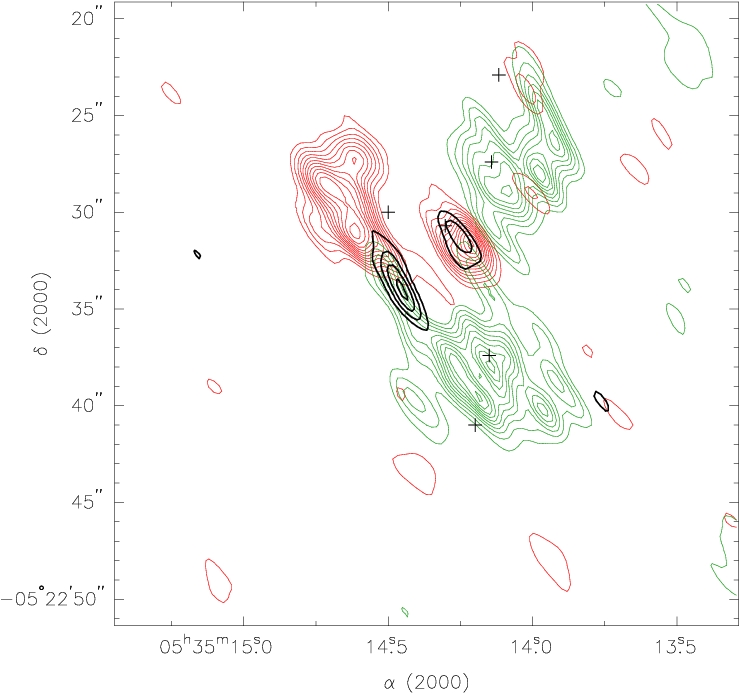Sagittarius B2(N)
This star forming region is near the center of the Milky Way (~7.1 kpc) and is the best known source of large molecules.
The spectral line survey is a partial survey with both a single element radio telescope (NRAO 12meter) and an interferometer (BIMA array) in order to obtain as much spatial information as possible. This figure shows the frequency coverage of the Sgr B2(N) survey. Black lines denote 12 meter coverage and red lines denote BIMA coverage. There is more BIMA coverage due to the double sideband BIMA receivers.

Spectra (pdf):
- 85.900-86.200 GHz BIMA & 12 meter
- 86.200-86.500 GHz BIMA & 12 meter
- 86.500-86.800 GHz BIMA & 12 meter
- 86.800-87.100 GHz BIMA & 12 meter
- 89.725-90.025 GHz BIMA & 12 meter
- 90.025-90.325 GHz BIMA & 12 meter
- 106.275-106.575 GHz BIMA & 12 meter
- 106.575-106.875 GHz BIMA & 12 meter
- 108.200-108.500 GHz BIMA & 12 meter
- 108.500-108.800 GHz BIMA & 12 meter
- 109.900-110.200 GHz BIMA & 12 meter
- 110.200-110.500 GHz BIMA & 12 meter
- 87.100-87.400 & 89.570-89.725 GHz BIMA
- 90.325-90.925 GHz BIMA
- 90.925-91.105, 106.200-106.300, 106.88-106.965, & 108.800-108.925 GHz BIMA
- 109.750-109.900, 110.500-110.535, & 111.730-112.030 GHz BIMA
- 112.030-112.495 GHz BIMA
A total 331 spectral lines were detected at the systemic velocity of 64 km s-1: 205 are identified as rotational lines from 40 species, 125 are unknown and 1 is a recombination line. Adiitionally, 86 spectral lines were detected from the 72 km s-1 core (5" north of Sgr B2(N): 73 are identified and 13 unidentified, and 24 spectral lines were detected at 52 km s-1. From the data the source sizes of the emission components could be directly measured. In general all of of the 64 and 72 km s-1 emission components from larger molecules (5+ atoms) were ~3" in size (~21,000 AU at the distance of Sgr B2(N)). A paper detailing the full analysis and results is currently being written. Please see my thesis for the initial analysis results.
Orion-KL
Orion-KL is the nearest region of high mass star formation (~450 pc) and is near the well known Orion nebula. The Orion-KL region is one of only a few places in the sky that exhibit chemical differentiation (oxygen bearing species and nitrogen bearing species exist in two distict areas). Thus this region can be a good testbed for chemical modelling theories.My specrtal line survey of Orion-KL covers 80-115.9 GHz at 392 kHz resolution (1-1.5 km s-1, depending on frequency). The spectra from the hot core (N rich) and compact ridge (O rich) can be found at the links below.
Compact Ridge Spectra
Hot Core Spectra
A total of 979 spectral lines were detected toward the hot core: 620 are identified and 359 are unidentified, and 790 spectral lines were detected toward the compact ridge: 518 are identified and 272 are unidentified. One highlight of the survey was the detection of acetone [(CH3)2CO] in Orion-KL and the first detection of vibrationally excited acetone in the interstellar medium (Friedel et al. 2005). Please see my thesis for a full description of the results.
Recent high resolution (~1.5") observations of several large molecules have shown that the Orion-KL region is not as simple as once thought. The N-bearing molecules are soming from both the hot core region and Irc7 while most O-bearing species are not coming from the compact ridge, but rather from IRc5 and IRc6. The notable exception to these rules is acetone, which only appears in the small regions where both N-bearing and O-bearing molecules overlap. See Friedel & Snyder 2008 for full details. The figure below shows a map of ethyl cyanide [C2H5CN], dimethyl ether [(CH3)2O], and acetone [(CH3)2CO]. From north to south the "+" marks indicate Orion BN, IRc6, hot core, IRc7, IRc5, and compact ridge.

